Everything you need to make rich, incredibly flavorful pork bone broth at home using raw pork bones either on the stove top or in an electric pressure cooker, or repurposing leftover pork bones for a simpler pork bone broth.

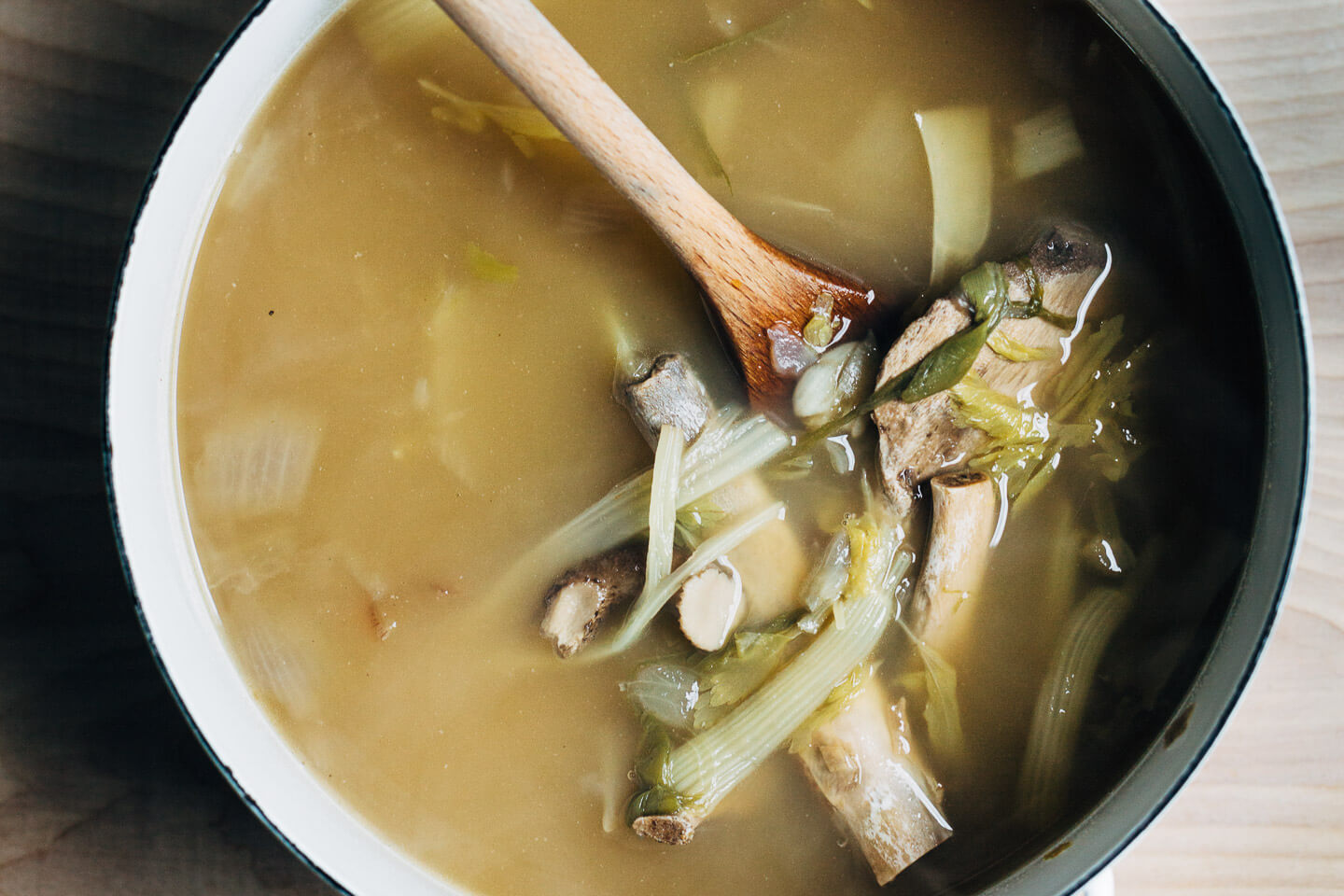
This pork bone broth recipe was originally published in April 2009, a time when Brooklyn Supper was in the midst of some lean times better known as the Great Recession. Since we find ourselves once again making do with what’s on hand and stretching our ingredients, I thought it was a good time to update the recipe.
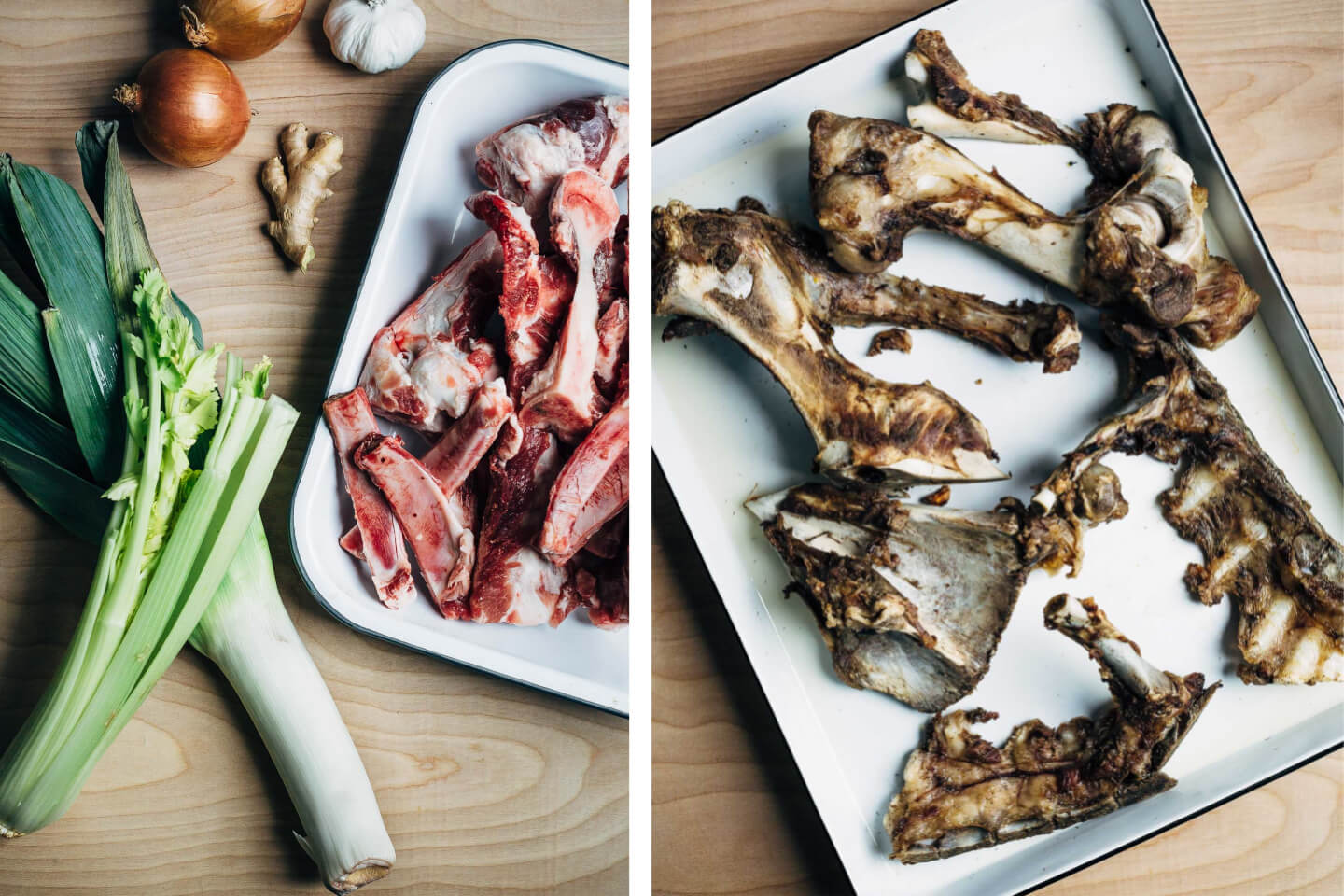
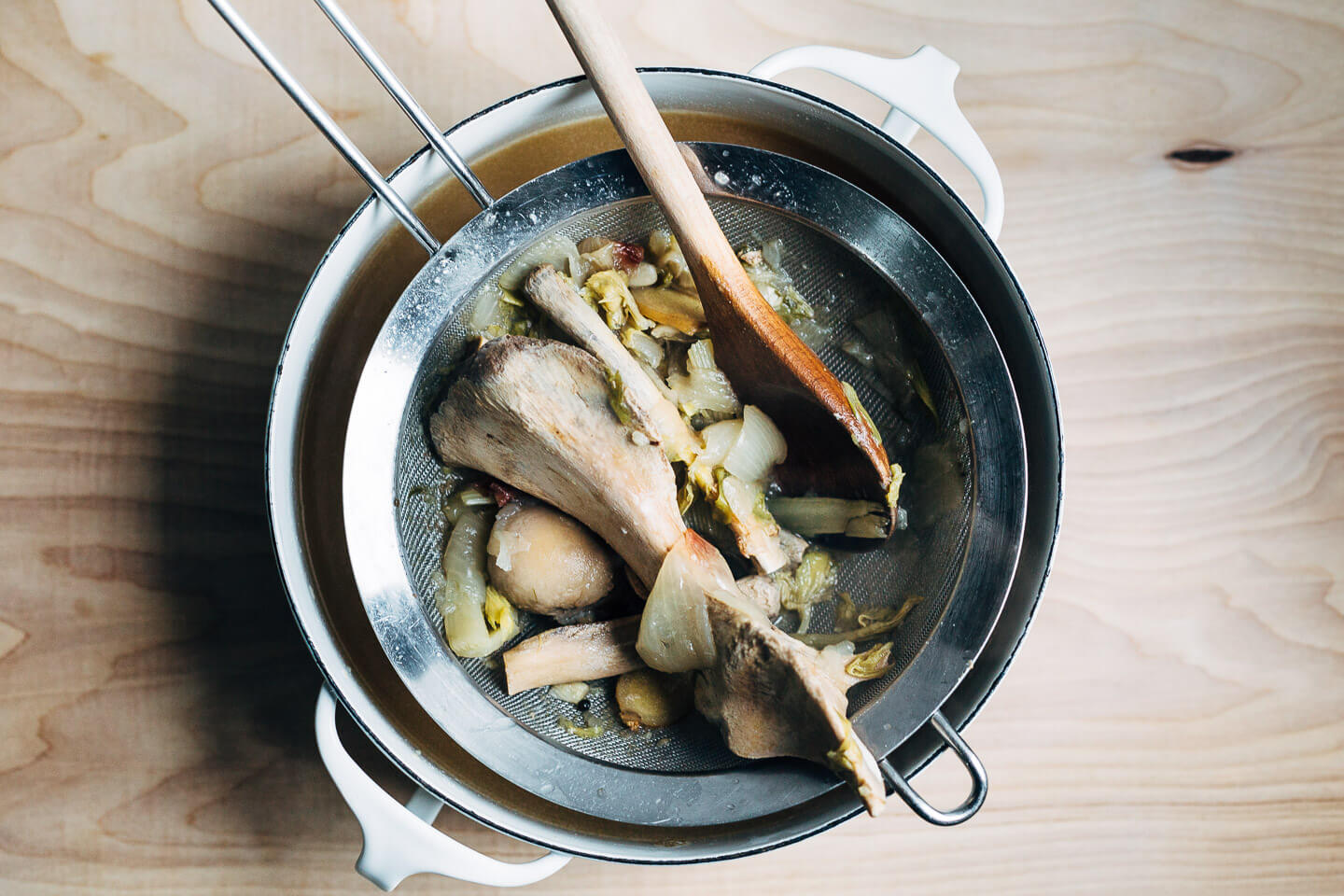
There are many, many ways to approach making bone broth. The original pork bone broth recipe published here was a casual way to repurpose a large quantity of pork bones – the kind you might have leftover from cooking a pork shoulder or have saved up in the freezer from multiple meals. This is the kind of bone broth I make most often. We save up chicken or pork bones and then use them to make a stock once enough have been accumulated. This simple approach is an important way to stretch animal ingredients and I’ve got a recipe for that approach below.
Making Pork Bone Broth from Raw Pork Bones: Stove Top or Pressure Cooker
But first, a more traditional pork bone broth made from a mess of pork bones I picked up at my local butcher. This recipe is fussier and has a few more steps, but makes for a rich, delicately flavored broth that’s an ideal base for ramen or other soups where the broth provides the bulk of the flavor.
I started by blanching the bones and skimming the broth as they cooked. This step pulls a lot of the most unctuous components from the bones and yields a more refined-tasting broth. Next up, I roasted the bones – this step amplifies flavor and renders some of the fat. Finally, I stewed my bones low and slow in a big stock pot (the bigger, the better) with a mix of leeks, yellow onions, celery, garlic, ginger, and peppercorns. This last step can be done on a pressure cooker or on the stove. The stove top version produced a paler, more gelatinous broth, while the pressure cooker bone broth was darker and more watery (a thick liquid as opposed to the fully gelled stovetop version). Both were delicious and very flavorful, though I’d recommend opting for the stovetop version if time allows.
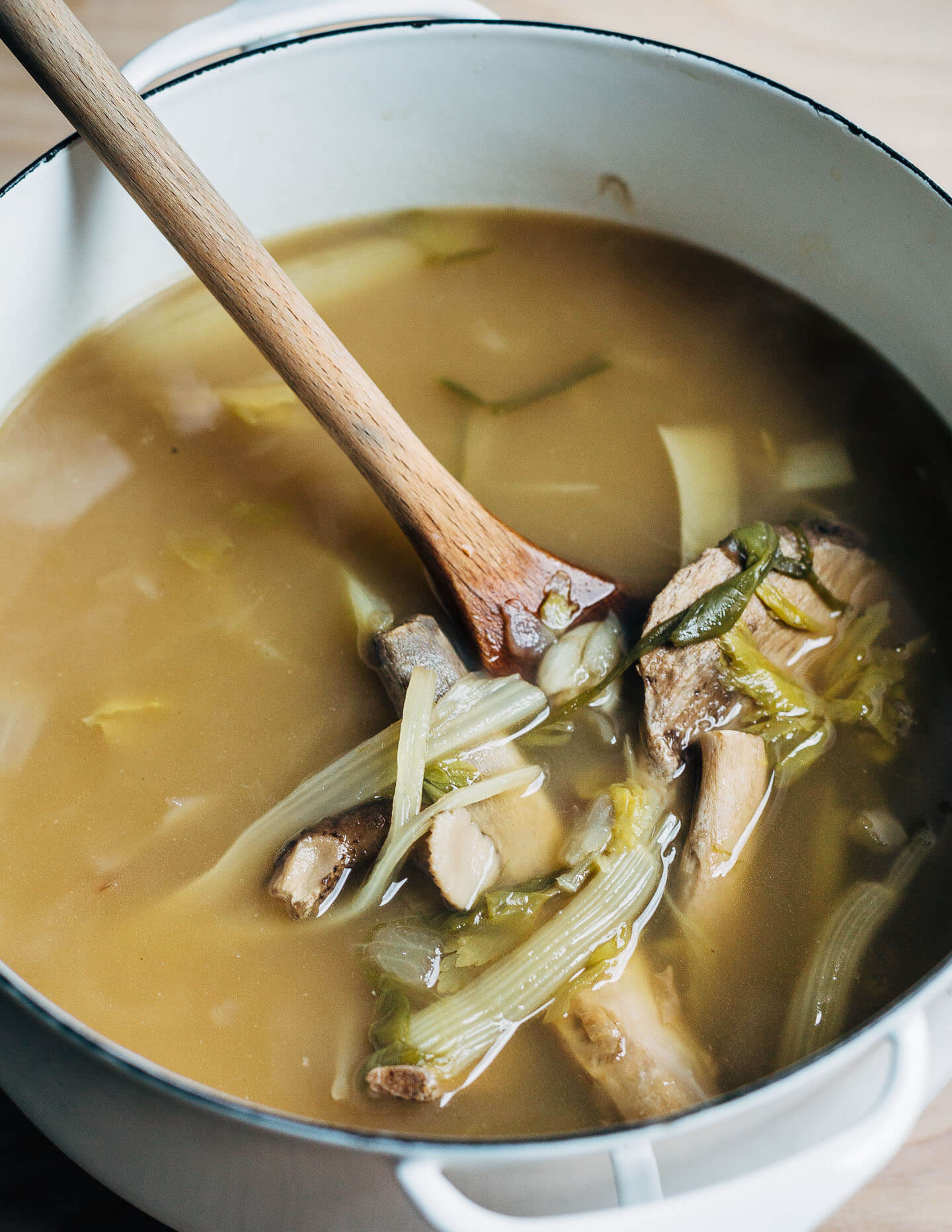
Uses for Pork Bone Broth
Serve your pork bone broth however you like. I added a splash of soy sauce and mirin to make for a simple, if exceptionally flavorful ramen broth. Other uses include a fortifying daily mug of broth, braising liquid, or as the base for sauces, stews, and bean dishes.

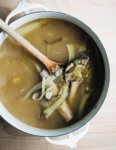
Everything you need to make rich, incredibly flavorful pork bone broth at home, either using raw pork bones from the butcher on the stovetop or in an instant pot, or repurposing leftover pork bones for a simpler pork bone broth.
Note that the amount of broth you can make will be limited in the Instant Pot. If making a stovetop version, consider doubling the recipe to maximize your pork bone broth output.
Because of the long cook time for the stove top version, consider prepping and roasting the bones a day ahead and starting your broth first thing the next morning.
- 3 pounds raw pork bones
- 1 large yellow onion, trimmed, peeled, and quartered
- 2 celery ribs
- 1 medium leek, roots trimmed, halved, and thoroughly cleaned
- 4 cloves garlic, peeled
- 1 2- inch section of ginger, sliced
- 20 peppercorns
- 2 tablespoons apple cider vinegar
- 1/2 teaspoon sea salt
-
Preheat oven to 400 degrees F.
-
Set bones in a large stock pot. Fill with cold water so bones are covered at least an inch. Bring to boil, then turn heat down to a rapid simmer and cook 20 minutes. While bones cook, skim any brown foam that rises to the top with a fine mesh sieve or slotted spoon.
-
Remove bones from the boiling water, shaking off excess water, and place in a rimmed baking sheet or two. Roast 30 minutes, or until bones are a deep brown hue and very fragrant. Discard blanching water.
-
To make pork bone broth on the stovetop, place roasted bones in the same stock pot used for blanching. Add onions, celery, leeks, garlic, ginger, peppercorns, and apple cider vinegar. Add 6 quarts cold water and bring to a boil, skimming any foam that rises to the top. Turn heat down to a gentle simmer (medium-low) and set a slightly askew lid on top. Simmer, stirring and skimming every hour or so for 10 - 18 hours. As broth cooks, edge heat down to low and add water as needed. I do not recommend leaving the broth unattended for any length of time. Add sea salt toward the end of cook time – it should be just enough to bring out the flavor.
-
To make broth in an electric pressure cooker, combine roasted bones and all remaining broth ingredients in the inner pot. Add 3 quarts cold water (no more than two-thirds of the way up the pot). Close lid and set vent to sealing. Cook at high pressure for 5 hours. Allow broth to manually release for 30 minutes.
-
Strain broth (I typically use a colander and then a fine mesh sieve). If desired, strain again through a fine mesh sieve lined with cheesecloth.
-
Pour broth into quart jars, and carefully set in the fridge. It's important to chill cooked broth quickly, so if you're leaving it in a large stock pot, consider immersing it in an ice bath first to quickly bring down the temperature.
-
To freeze broth, fill wide mouth quart jars with broth just up to the curve in the glass (for about 2-inches of head space). Allow broth to chill overnight in the fridge, then label jars, and freeze for up to 6 months.

- 2 pounds cooked pork bones
- 2 tablespoons olive oil
- 2 yellow onions, quartered
- 2 celery ribs, cut into 4-inch segments
- 4 cloves garlic, peeled
- 20 peppercorns
- 2 tablespoons apple cider vinegar
- ½ teaspoon sea salt
-
In a large stockpot over medium heat, sauté onions, celery, and garlic in olive oil. When they have softened, after 5 minutes, add the bones and fill the pot with 5 quarts cold water. Add the bay leaves, peppercorns, and apple cider vinegar, and bring to a boil. Skim any brown foam that rises to the top with a fine mesh strainer or slotted spoon. Turn heat to low/medium-low so that broth is simmering gently. Set a slightly askew lid on top of the stockpot. Cook, stirring and skimming every hour or so, 6 - 8 hours. Add sea salt when there's about an hour of cook time left – just enough to bring out the flavor.
-
When you are satisfied that your broth has achieved its maximum potential, strain through a mesh strainer. Pour into clean quart jars, allowing a full 2-inches of head space if you plan to freeze the broth. Set jars in the fridge right away and cool completely in the fridge overnight, then label and freeze. Frozen broth will keep for 6 months, especially if you push it to the very back of your freezer.
I am going to try this today, I have some leftover pork bones from a pork roast. I thought it might make a nice base for a bean soup.
This seems to be delicious results!
I am right now going to try this recipe.
My ingredients ready .
Thank you.
This makes a really flavorful broth, and I think it will make fantastic bean soup. Let me know how it turns out!
hi – I live in China and pork is the main meat around here. I am so excited to find this recipe! It’s better than using those MSG cubes!
Thanks for this recipe!
(Former NYC resident)
Hi Jacqi u prob no there anymore – not cooked pork before? Get a bacon leg does same job & more meat for leftovers
Do you need to use a pressure canner for this since there’s meat involved or would the same method to make jams shelf stable work?
Hi Andrea, The broth in the recipe is meant to be frozen or eaten right away. We didn’t create this recipe to be canned, though I’m sure there are a lot of resources out there for properly canned meat-based stock.
I’m having trouble finding info to tell me if this is safe to put in jars and pressure can so I’m going to play it safe and freeze it.
This recipe is NOT MEANT FOR CANNING. It is not safe to can.
You most definitely can ‘can’ this stock, same as chicken stock. However, you MUST have a “pressure canner” with a calibrated pressure gauge. A quick Google search will give you the times etc. It is time consuming but if you make gallons of stock as I do, it’s nice to have it on a shelf instead of occupying the freezer.
We just spit-roasted a small (40 lb) pig for an Autumnal Equinox party for 35 people. The meat from a young pig like this simply pulls off the bones, leaving a large amount of bone. I’m happy to find this simple recipe for pork broth; I expect to get a couple gallons. Will it be a suitable substitute for chicken broth in my roasted tomato soup?
…I meant to add, I have almost ten lbs of skin, bones and head.
Hi Ron, Sounds like an amazing feast! Brian and I are more than a little jealous. Here’s what we think: add the bones and skin for sure. We just don’t have any experience with pig heads (aside from eating) so I am not sure how the head boils up. If you do add the skin, I would spend a good deal of time skimming all the gray bits and foam that float to the top. Otherwise, you should be good to go. As for your soup, I think it will be fantastic! If your broth is particularly gelatinous, and I’m guessing it will be, you may want to add a little less broth than usual since it could be a lot more flavorful than the average chicken stock. Good luck!
Do you discard the water used for blanching or do you reuse in addition to the 6 quarts of cold water? Also, do you use the entire leek or just the root?
Hi Ryan, Definitely discard the blanching water. As for the leeks, I trim the roots off, rinse any sand from between the leaves and use the whole thing. You may need to chop it into sections so it fits in your pot.
The vinegar was never mentioned in the recipe for the leftover bone broth after the ingredients list
Hi Caroline, It goes in with the peppercorns and bay leaves. I’ll update the recipe now. Thanks for catching that.
It’s not mentioned in the original recipe either
Just updated – thanks Nicole!
I just made the stove top recipe for pork broth. It is in the fridge now. Should I remove the fat at surface in the morning when cooled???
I’m not seeing the Bay Leaves anywhere in the ingredients list.
Can you cook this in a crockpot?
I did. Put it in the freezer after straining and let the fat congeal. Removed all fat and strained through cheesecloth. Delicious and beautiful! I also roasted them for 45 minutes instead of 30
Do you have a recipe to turn this into a japanese pork soup broth?
I’ve made this twice (the slow way) and it was fantastic both times!
Why do you skim the blanching liquid if you’re just going to discard it anyway?
In my experience, if not skimmed, the foam can break down and dissolve into the broth. If I’m going to the trouble to make my own broth, I like to make sure it will have the best flavor. If it’s too cumbersome for you, it’s ok to skip.
1/4 of a pigs head (brains and eye removed) and 1 leg cut up made a unbelievable bone broth over a 36 hour period.
I just have one question, when it’s mentioned to turn the heat to low and add water as needed… what are you looking for exactly? Do you want to keep the liquid level the same as you started?
After I boil and bake can I use my slow cooker (it’s a 9 in one) to finish for 12 hours? Of course still skim it.
Sure, that should work just fine, Colleen.
you mentioned that bay leaves go in with peppercorn; however, I don’t see bay leaves in ingredients list…how many do you use? Thanks 🙂
What’s the recipe for the picture at the top that uses the broth? Looks delish 🙂